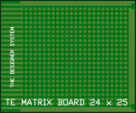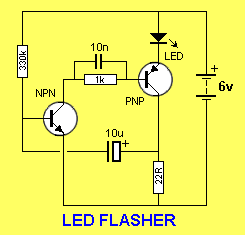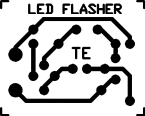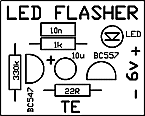http://www.google.com.bd/imgres?imgurl=http%3A%2F%2Fwww.electronicsteacher.com%2Fcircuits-and-diagrams%2Finfrared-based-schematics%2Ftransmitter.gif&imgrefurl=http%3A%2F%2Fwww.electronicsteacher.com%2Fcircuits-and-diagrams%2Finfrared-based-schematics%2F&docid=JqVXicLTcK_CUM&tbnid=vmphuOV0QFN79M&w=934&h=513&ei=8hPOUZ71BaiTigfh9oGQBA&ved=0CAQQxiAwAg&iact=c
This is default featured slide 1 title
Go to Blogger edit html and find these sentences.Now replace these sentences with your own descriptions.
This is default featured slide 2 title
Go to Blogger edit html and find these sentences.Now replace these sentences with your own descriptions.
This is default featured slide 3 title
Go to Blogger edit html and find these sentences.Now replace these sentences with your own descriptions.
This is default featured slide 4 title
Go to Blogger edit html and find these sentences.Now replace these sentences with your own descriptions.
This is default featured slide 5 title
Go to Blogger edit html and find these sentences.Now replace these sentences with your own descriptions.
Friday, June 28, 2013
5:47 PM
No comments
http://www.google.com.bd/imgres?imgurl=http%3A%2F%2Fus1.webpublications.com.au%2Fstatic%2Fimages%2Farticles%2Fi1030%2F103012_5mg.jpg&imgrefurl=http%3A%2F%2Fgalia.fc.uaslp.mx%2F~cantocar%2Fmicrocontroladores%2FPICAXE%2FSILICON_CHIP_ONLINE___PICAX.HTM&docid=hZjzGE6IBr4_tM&tbnid=IQhu6jBh_V-D3M&w=782&h=512&ei=8hPOUZ71BaiTigfh9oGQBA&ved=0CAUQxiAwAw&iact=c
5:46 PM
No comments
http://electronics.stackexchange.com/questions/33435/how-do-i-calculate-the-frequency-of-an-fm-transmitter-circuit
5:45 PM
No comments
|
Below is an FM transmitter circuit I found on the web that I would like to build from scratch.
 How I would calculate the carirer signal frequency so that I know where to tune my FM radio? If I want this to transmit my own signal, instead of the microphone signal, could I just replace the microphone with the output of a TRS connector? |
|||||||||||||
|
|
F = 1/(2*pi*sqrt(L*C))
L and C2 are components oscillator but this is a very awful bad circuit. 1 transistor as oscillator an as modulator is not the way to do it it isn't as stable as an regular modular transmitter for just a sine out you wont use this circuit you could look on the Internet for
For just data send and receive google for 433MHZ serial data 433 psk data 433 spi ... |
|||||||||||||
|
|
It's not exactly clear what you mean by
"transmit a single wave, not whatever the microphone outputs". Is that
OOK (On-Off Keying)?
It's not worth the trouble and the money to start building a transmitter yourself (unless the purpose is in the building, not the use). Digikey lists 433MHz transmitters for around 4 dollar:  This one can send data at up to 3kHz and has a range of 50m. Check the Digikey site (or another distributor) if your requirements are different. |
|||
5:33 PM
No comments

The problem statement, all variables and given/known data.
I am just trying to understand this cicuit a little better. Especially the right half, I know that the left half is just acting as an amplifier but I'm not sure how the right half works. Also how is the frequency being modulated here?
The attempt at a solution.
I know that C5 and L2 are used to calculate the carrier frequency, but I am very unfamiliar with this type of set up for Q2. Any help would be greatly appreciated!
Tuesday, June 25, 2013
12:55 PM
No comments
BC549C Condenser Microphone Pre Amplifier | 5,184 view(s)
>ElectroSuite>.com – BC549C Condenser Microphone Pre Amplifier. This is a very simple preamplifier circuit for condenser microphone. This mic preamplifier also can be used for dynamic microphone.
BC549C Condenser Microphone Pre Amplifier – Schematics.circuitdiagram.net
12:18 PM
No comments
FOUR-STAGE FM TRANSMITTER 
PRADEE G.
This
FM transmitter circuit uses four radio frequency stages: a VHF
oscillator built around transistor BF494 (T1), a preamplifier built
around transistor BF200 (T2), a driver built around transistor 2N2219
(T3) and a power amplifier built around transistor 2N3866 (T4). A
condenser microphone is connected at the input of the oscillator.
Working of the circuit is simple. When you speak near the microphone, frequency-modulated signals are obtained at the collector of oscillator transistor T1. The FM signals are amplified by the VHF preamplifier and the pre-driver stage. You can also use transistor 2N5109 in place of 2N2219. The preamplifier is a tuned class-A RF amplifier and the driver is a class-C amplifier. Signals are finally fed to the class-C RF power amplifier, which delivers RF power to a 50-ohm horizontal dipole or ground plane antenna. Use a heat-sink with transistor 2N3866 for heat dissipation. Carefully adjust trimmer VC1 connected across L1 to generate frequency within 88-108 MHz. Also adjust trimmers VC2 through VC7 to get maximum output at maximum range.
Regulator IC 78C09 provides stable 9V supply to the oscillator, so variation in the supply voltage will not affect the frequency generated. You can also use a 12V battery to power the circuit.
Assemble the circuit on a general-purpose PCB. Install the antenna properly for maximum range. Coils L1 through L5 are made with 20 SWG copper-enamelled wire wound over air-cores having 8mm diameter. They have 4, 6, 6, 5 and 7 turns of wire, respectively.
EFY note. This transmitter is meant only for educational purposes. use of this transmitter with outdoor antenna is illegal in most parts of the world. The author and EFY will not be responsible for any misuse of this transmitter.
Working of the circuit is simple. When you speak near the microphone, frequency-modulated signals are obtained at the collector of oscillator transistor T1. The FM signals are amplified by the VHF preamplifier and the pre-driver stage. You can also use transistor 2N5109 in place of 2N2219. The preamplifier is a tuned class-A RF amplifier and the driver is a class-C amplifier. Signals are finally fed to the class-C RF power amplifier, which delivers RF power to a 50-ohm horizontal dipole or ground plane antenna. Use a heat-sink with transistor 2N3866 for heat dissipation. Carefully adjust trimmer VC1 connected across L1 to generate frequency within 88-108 MHz. Also adjust trimmers VC2 through VC7 to get maximum output at maximum range.
Regulator IC 78C09 provides stable 9V supply to the oscillator, so variation in the supply voltage will not affect the frequency generated. You can also use a 12V battery to power the circuit.
Assemble the circuit on a general-purpose PCB. Install the antenna properly for maximum range. Coils L1 through L5 are made with 20 SWG copper-enamelled wire wound over air-cores having 8mm diameter. They have 4, 6, 6, 5 and 7 turns of wire, respectively.
EFY note. This transmitter is meant only for educational purposes. use of this transmitter with outdoor antenna is illegal in most parts of the world. The author and EFY will not be responsible for any misuse of this transmitter.

http://www.electronicsforu.com/electronicsforu/circuitarchives/view_article.asp?sno=67&article_type=1&id=464&tt=unhot
&
http://www.electroschematics.com/5594/four-stage-fm-transmitter/
Friday, June 21, 2013
5:57 AM
No comments
Basic Electronics Course
Page 83 This page comes from our Basic Electronics Course It is so important, we have added it to the FREE section. The complete BEC is in the subscription section Some circuits in this discussion are available from Talking Electronics as kits. (or this link for the web: Talking Electronics) All the circuits can be built on our Matrix Boards. (or this link for the web: Matrix Boards)
Flashing circuits are very interesting. They grab your attention and can be used in many applications. They consume very little energy and a single cell can last as long as 12 months. You can flash globes, LEDs and pulse all types of devices such as motors, solenoids and piezo diaphragms. In this discussion we will cover a number of interesting "oscillator circuits." They can be adapted for other applications - but to do this you have to know how they work. This is not easy as most of them are quite complex. In fact oscillator circuits are one of the most difficult circuits to understand. But if you read the text, everything will become clear. Flasher circuits have developed over a long period of time, with many of the earlier designs proving to be unreliable. One of the earlier successful designs is discussed in our article, Spot This Mistake P4 (or use this link for the web: P4). The first circuit we will cover is the first project you should build, it is: THE LED FLASHER K-LF1 $3.10 This is a very simple project using a printed circuit board and 8 components. It will flash an ordinary 3mm or 5mm (1/8" or 1/4") LED at a rate of about one flash per second.
A complete kit for this project is
available from Talking
Electronics. (or:
Talking Electronics)
The circuit has a couple of advantages over a flashing LED you
can buy as an individual item. It pulses it with a higher peak
current to give a brighter illumination and consumes less average
current. This means it will work for a long time
on an almost flat battery and cost nothing to run. It can be used
for battery equipment to indicate the power is ON or as an ALARM ON
indicator.
You can use a super-bright LED and get a really bright flash, or an ordinary
green, orange or yellow LED to get something better than a flashing red LED.
THE CIRCUIT
This circuit works on the basis of a high-gain amplifier being driven into saturation (fully turned-on), firstly by the very small amount of current delivered by a high-value resistor and then from energy stored in an electrolytic. When the energy from the electrolytic has been fully delivered, it cannot keep the amplifier fully turned on and it turns off slightly. This action removes the "turn-on" effect from the electrolytic and the amplifier begins to turn off. This action continues until the amplifier is fully turned off and is kept in the off state while the electrolytic begins to charge. The off-state is very long and the on-state is very short. This is how the LED produces a brief flash. Here is the technical description of the operation of the circuit: When the supply is connected, both transistors are off and the electrolytic charges via the 330k resistor and 22R. When the voltage on the base of Q1 rises to about .6v, the transistor begins to turn on and the resistance between its collector-emitter terminals is reduced. This allows current to flow in the collector-emitter circuit and Q2 is turned on via the 1k resistor. The 10n reduces the effect (the resistance) of the 1k resistor. Q2 conducts and the LED is illuminated. The current through the LED is limited by the 22R resistor and at this point in the cycle a voltage is developed across the 22R. The negative end of the electrolytic is `jacked up' by this voltage and the positive end pushes the charge on the electrolytic into the base of Q1 to turn it on even harder. In a very short time all the energy in the electrolytic has been delivered to Q1 and it cannot hold Q1 ON any longer. The transistor turns off slightly and this has the effect of turning off Q2 a small amount. The LED begins to turn off and the voltage across the 22R reduces. The negative lead of the electro drops a small amount and so does the positive lead. This action continues around the circuit until Q1 is fully turned off. This turns off Q2 and the LED is extinguished. The cycle starts again by the 10u charging. The charge-time is considerably longer than the discharge time and this gives the LED a very brief flash. CONSTRUCTION All the parts mount on a small PC board and it has an overlay (all our boards have overlays) as shown in the diagram below: 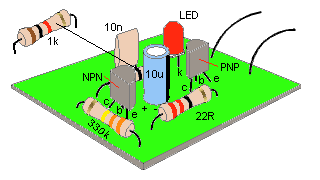 Mounting the components
This makes construction very easy and all you have to do is bend
the leads of the components so they pass down the holes in the board. The
resistor leads are bent to 90° and are
pushed
all the way down so they rest on the board. The leads are then bent
slightly to hold them in place while the leads are soldered.
Fit the three resistors in this way and you are ready for the two
capacitors. The 10n can be fitted either way around but the 10u
electrolytic must be fitted so the positive lead goes down the hole marked with
a "+." The positive lead is the shorter of the two
leads
and the
negative
lead is marked on the side of the body of the component with a "
—"
The two transistors are next and it is important not to mistake the PNP for the NPN. They both look identical. Check with the parts list for the types you have been given in the kit. Fit the leads down the holes so that the transistor is 2mm (1/8") from the board and bend the leads slightly so it does not fall out when the board is turned over and soldered. Finally the LED is fitted to the board. 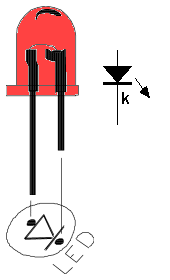 Fitting the LED
Refer to the
diagram above for the identification of the cathode lead. Keep the LED above the board so
it can be clearly seen. Solder a short length of red and black wire to the board
and to 4 cells to complete the project. You can use almost any old cells for
the 6v supply and let the LED FLASHER use them up completely.
1.5v LED FLASHER The next circuit flashes a LED and uses a 1.5v supply. The LED does not turn on via the 1k resistor because the characteristic voltage of a LED is between 1.7v and 2.3v, (depending on the colour). It turns on when the 100u is "jacked up" by the collector of the BC557. The circuit is a charge-pump design. This is where a capacitor (electrolytic) is allowed to charge and is then raised higher and allowed to discharge into a load. The load sees a voltage that can be higher than the supply. This is the case with this circuit. The two transistors operate as a high-gain amplifier with the output being the 47R. The cycle starts with the first transistor being turned on via the 100k. This action also charges the 10u until 0.75v appears on the base of the transistor. This turns on the second transistor and the negative end of the 10u is raised when the BC557 turns on. This raises the positive end of the 10u and the first transistor turns on even more. This action continues until the first transistor is fully turned on and the BC557 is fully turned on. The voltage across the collector-emitter terminals of the BC557 will be small and about 1v will appear across the 47R. This voltage "jacks up" the 100u and since it is fully charged via the 1k resistor, it will present a voltage of about 2.5v to the LED. Any voltage over 1.7v will turn on a red LED and a green LED will turn on at 2.3v. The energy in the 100u is now passed to the LED to illuminate it. The flash is very brief due to the operation of the two-transistor amplifier. Although the energy in the 100u will produce a brief flash, the timing of the two transistor circuit is even faster and it provides the duration. The actual duration of the flash depends on the time the two transistor amplifier can be in a fully turned-on state. This is governed by the charging of the 10u electrolytic. When the base of the first transistor sees 0.7v, the two transistors start to turn on by a process called REGENERATION. This is explained further in our article: REGENERATION, in Circuit Tricks. Regeneration is a condition where a circuit turns on more and more without any external assistance. And this is what happens in this circuit. The 10u is "jacked up" by the BC557 turning on and it delivers a current to the base of the BC547. Initially it delivers its energy to the base but very soon is is higher than 0.7v and it is fully discharged. The electrolytic now starts to charge in the reverse direction and this process continues to keep the BC 547 turned on. It charges very quickly in the reverse direction as the charging path is the emitter-collector junction of the BC557 and base-emitter junction of the BC547. When it is nearly charged, the current-flow reduces and this turns off the BC547 very slightly. This turns off the BC557 slightly and the 10u is "lowered." This puts less "turn-on" on the BC547 and the two transistors start to turn off very quickly. The 10u is now charged in the reverse direction and a negative voltage is presented to the base of the first transistor. This voltage is is gradually reduced by the electrolytic charging via the 100k and that's why the circuit has a very long off cycle. Two circuits are shown. They use slightly different components to produce the same results. The only critical value is the 100R. The circuit will not work with a value higher than about 150R. It needs a low value so the BC557 transistor is turned on to a high level before a voltage is developed across the 100R. If the value is too high, a voltage will be developed across this resistor when the BC557 is turned on a small amount and this voltage will be sent to the BC547 to turn it on too. The two transistor will sit in a conditions that they are both turned on and the circuit will freeze. The circuit has to function such that the BC547 is turned on to its maximum when the electrolytic is pulled HIGH. This transistor will now be turned on by the current delivered by the 100k (or 1M) plus the charging current of the electrolytic. As the electrolytic charges, the current into the base of the BC547 will fall and the transistor will turn off slightly. This slight turn-off must be passed to the BC557 to turn it off slightly too and lower the "turn-on" effect of the electrolytic. It is the 47R (or 100R) that is pulling the electrolytic down to the 0v rail and if this resistor does not have sufficient "pull-down" effect, the cycle will not continue. When this resistor has a low value, the BC557 must deliver a high current and it must be turned on via a proportionally high current into the base. This current comes from the BC547 and it needs a proportionally high current into its base to provide this condition. We are only talking about fractions of milliamps and microamps, but these conditions must be met for the circuit to work. 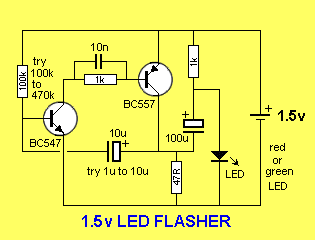 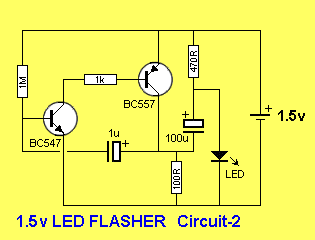
The next circuit replaces a flasher chip. These are no longer available but
many circuits use them. Here's the alternative:
THE LM 3090 FLASHER CHIP The LM3909 flasher chip has been discontinued for a number of years and the following circuit can take its place: 
When power is applied, the 100u is uncharged and zero voltage is across its
terminals.
It is charged via the two 470R resistors and 10k resistor and these three resistors create a voltage divider across the 1.5v supply such that the voltage on the top of the 10k resistor is about 1.4v This makes the emitter of the middle transistor about 1.4v and thus it is not turned on. The BC 557 is also not turned on and the first transistor is also not turned on. As the 100u charges, the voltage across the 10k resistor decreases and the middle transistor begins to turn on. This turns on the BC 557 and the first transistor begins to turn on very quickly and very soon it is fully turned on. This effect brings the positive of the 100u towards the 0v rail and the best way to see how the voltage across the electrolytic adds to the 1.5v supply to produce a voltage above 2v, is to refer to the following diagram: 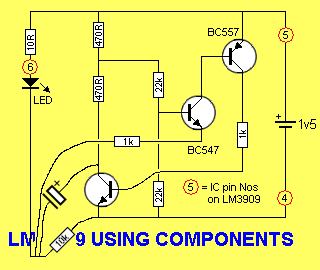
The voltage on the top of the 10k resistor actually goes about 1v below the 0v
rail and makes the 10k dip down as shown in the diagram above.
There is one very important requirement when designing an oscillator.
The timing capacitor must be discharged. In other words the circuit must create a state that discharges the capacitor and remains in that state until the capacitor is fully or almost fully discharged. If it is not discharged, it cannot be charged again! HOW THE CIRCUIT WORKS So, let's start at the beginning: The analysis of the circuit starts at the base of the middle transistor. The voltage at this point is approx half the supply voltage when the circuit is turned on as no transistor is conducting and the electrolytic is discharged. Since the voltage on the circuit is only 1.5v, the LED is a very high impedance at this voltage as it does not activate until the voltage is above its characteristic voltage of approx 1.7v. The only components that are effectively "in circuit" are shown in the following diagram, and the electrolytic begins to charge: 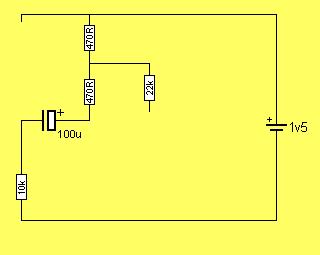 Charging the electrolytic
When the circuit is first tuned on, the electrolytic has zero voltage across
it and the 10k and 470R resistors are in series. About 0.13v is across the two
470R resistors and 1.37v is across the 10k resistor.
As the electrolytic charges, the voltage across the 10k reduces. The following animation shows how the voltage across the 10k changes: 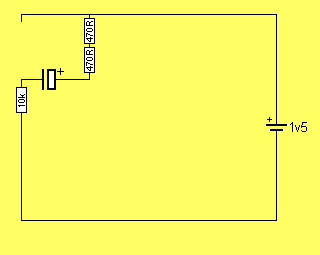 The electrolytic charging
As the electrolytic charges to about 1.2v, the middle
transistor begins to turn ON as the voltage on the top of the 10k resistor
drops from 1.37v to about .17v.
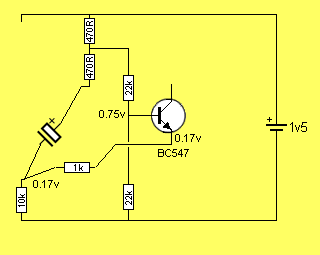 The voltage on the transistor turns it ON
The voltage between the base and emitter of the transistor is 0.58v and the
transistor begins to turn on.
The transistor used in the prototype turned on at 0.38v and this is the secret behind the circuit operating down to a supply voltage of about 0.8v In the diagram below, the middle transistor is turned on slightly and this turns on the third transistor. The third transistor turns on the first transistor. 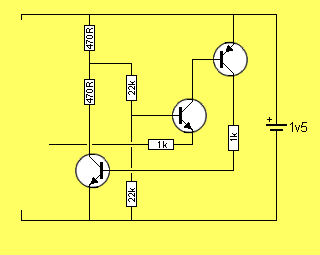 All the transistors are turned ON
The first transistor pulls the lower 470R resistor towards the 0v rail and
the positive end of the electrolytic. The negative end is also pulled down as
shown in the following animation:
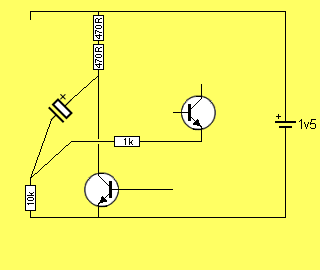 The electrolytic getting pulled to the 0v rail
Here is the clever part:
As the electrolytic charges, the emitter of the middle transistor is being pulled down and the base is being pulled down at half the rate. This means the voltage between the base and emitter is widening and the transistor is being turned on MORE. This is called REGENERATIVE ACTION. The action continues until the first transistor is fully turned ON. 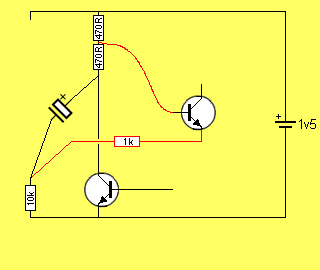 The voltage between base and emitter increases Here is a circuit using the LM 3909: 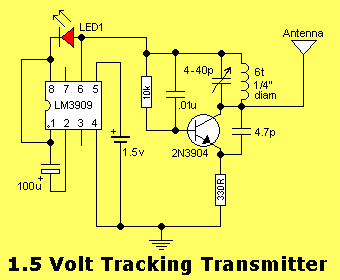
The FM transmitter section above operates continually from the 1.5v and the
"flasher chip" provides a slight interruption to create a "beep" on the
airwaves which is really the transmitter shifting off frequency and the
carrier being lost. It does not use the "jacked-up voltage" feature of the
chip.
If a load other than a LED is connected to the circuit, the electrolytic will not charge. The circuit relies on the fact that the LED is an "open-circuit" when the supply voltage is below the characteristic voltage of the LED (approx 1.7v). The circuit, however, can be used as an oscillator to drive other loads providing the LED and electrolytic are retained as they provide the "timing component" and "load." This makes the circuit very wasteful with current if required for other applications. There are other circuits more suitable, as you will see. Next, we have the astable multivibrator, or FLIP FLOP [pronounced (h)ay stable] - meaning it has unstable states. In this case, two unstable states. THE FLIP FLOP This is the simplest circuit capable of alternately flashing two LEDs. The flash-rate is determined by the two 10k resistors and two 100u electrolytics. The flash-rate can be increased or decreased and one LED can be made to flash brighter by altering the 4 components. The operation of the circuit is fully discussed in the Basic Electronics Course P17 & P19 (subscription needed) and in 5 Projects P16. (use this link for the web: 5 Projects) It can be purchased as one of the kits in 5 Projects. (use this link for the web: 5 Projects) This circuit does not have the advantage of the two described above. It does not pulse the LED with a high current for a short period of time and thus it is not as efficient as the two above. When a LED is pulsed with a high current for a very short period of time, the output is almost as bright as a constant, lower-current. 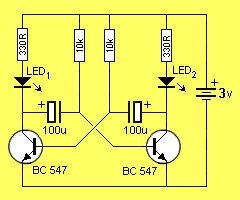 THE FLIP FLOP
Here are some Flashing LED
circuits from "200 Transistor Circuits' eBook. The first 4 circuits show how
to change an NPN transistor for PNP.
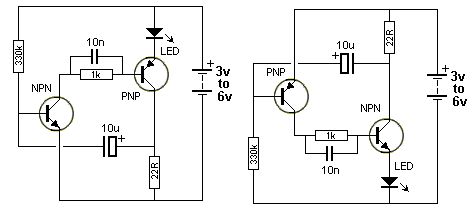 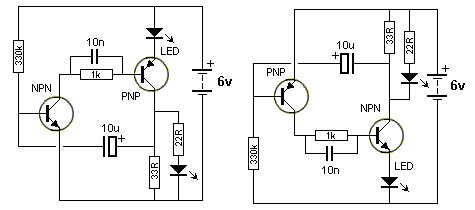 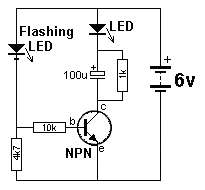 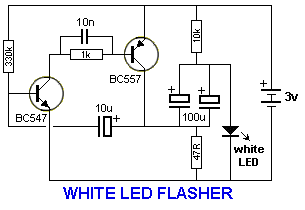 UNCONVENTIONAL CIRCUITS: The following circuit converts 1.5v to a voltage that is higher than the reverse break-down voltage of the emitter-collector junction of the BC547. When this voltage is reached the junction breaks-down and creates a low voltage across it. This allows the voltage on the 100u to pass to the white LED and create a flash. The voltage across the 100u drops and the junction comes out of conduction and the cycle repeats. 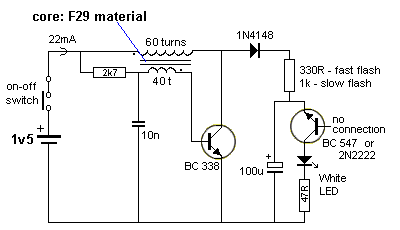
The next circuit uses the same
"Junction Breakdown" phenomenon but this time the high
voltage is supplied by a 12v to 20v battery.
All transistors have a single junction or two junctions between each pair of leads. They are called a "PN" junction or a PNP junction or an NPN junction - depending on which leads are selected. The junctions between each pair of leads behave differently, however the junction(s) we are interested in, is between the collector and emitter leads. When a voltage is applied to these leads in the reverse direction, an unusual thing happens. As the voltage is increased, the junction suddenly breaks down and a high current will flow , according to the energy available from the electrolytic. This occurs at a voltage of between 12v and 20v, (some transistors will require a higher voltage) depending on the type of transistor and the manufacturer. When the voltage across the leads falls, the current stops. In other words, the resistance between the two leads decreases when the voltage rises to between 12v and 20v (and the voltage across the two leads is about 0.5v and this is a characteristic of the junction). When the supply-voltage drops, the junction-resistance increases and the electrolytic charges. This feature can be used to flash a LED as shown in the following diagram: 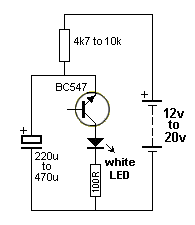 Flasher circuit using "Junction Breakdown"
The circuit above is very unreliable and only works with some transistors. The
voltage is very important. It must be high enough to cause the junction(s)
between the emitter and collector leads to breakdown.
The flash-rate will depend on the value of the top resistor and the electrolytic and also the voltage at which the transistor break-down. The circuit consumes less than 1mA and the 100R prevents a high current flowing through the LED (from the electrolytic). Without the 100R, the LED is destroyed instantly. The circuit is a very good demonstration of breakdown but due to the high supply voltage needed, it is not a practical design. The previous circuit should be used. LAMP FLASHERS The following circuits will flash a car globe for a Warning Beacon. It uses two Darlington transistor in a flip-flop circuit. The layout must be kept "tight" (thick wires) to be sure it will oscillate. A complete kits of parts and PC board costs $5.00 plus postage from: Talking Electronics. Email HERE for details. Warning Beacon
The following simple circuit flashes a globe at a
rate according to the value of the 180R and 2200u electrolytic.
 Simple Flasher
The Flasher can alternately flash 2 globes as shown in the following circuit.
You will need to adjust the value of the components to get an equal
flash-rate for the two lamps. It is a mechanical equivalent to the flip-flop
circuit above.
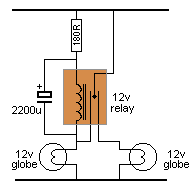 Dual Flasher
7-1-2011
| |||||||||
5:43 AM
No comments
Dick Cappels' Project Pages
Questions about projects on this site gladly answered.

(Address is an image -please type it in.)

http://projects.cappels.org/
(NEW PROJECTS MIGHT NOT SHOW UP UNTIL YOU REFRESH YOUR BROWSER WINDOW)
Microcontrollers, Analog, RF, and all three mixed.
Questions about projects on this site gladly answered.

(Address is an image -please type it in.)

http://projects.cappels.org/
(NEW PROJECTS MIGHT NOT SHOW UP UNTIL YOU REFRESH YOUR BROWSER WINDOW)
Microcontrollers, Analog, RF, and all three mixed.
Most projects can be assembled from readily
available parts without the need for specialized equipment. My
hope is that you will these projects helpful, and at least be
able to make use of some of the bits and pieces you will find
among them
Test and Measurement
Voltage Recorder With Playback (ATMEGA48V) NEW Jaunray 2013
A Simple Attenuator And Preamp For DC Measurements (Analog Only) NEW Jaunray 2013
An Even Better LC Meter Based on Atmel AVR ATTINY861
A Pretty Good LC Meter Based on an AVR (ATtiny2313, AT90S2313)
A Simple Manual Curve Tracer (analog only)
A Photocell Amplifier for Comparative Light Measurements (analog only)
A 10 Bit LED Digital Panel Meter With Auto Ranging Based on ATMEGA 8 ATMEGA8
An Isolated Variable AC Mains Transformer
MAX038 Function/Sweep Generator with Markers (ATtiny2313, AT90S1200A)
A Noise Generator per IEC 268-1, IEC 268-5, and IEC 268-7
1.000 kHz Sine Wave Generator ATTINY2313/AT902313/ATMEAG8515/AT908515, etc.
LED Wink Tester For 1.5 Volt Cells NEW February 2012
Battery Voltage Checkers
LC Determination by Resonant Frequency Measurement (ATtiny2313, AT90S2313)
Inductance meter for RF Inductors
HF/VHF/UHF Test Oscillator
A Little More Serious Frequency Meter/Counter(ATtiny2313, AT90S2313)
A 300 MHz Prescaler and 30 MHz preamp for A Little More Serious Frequency Meter
Frequency Meter and Pulse Generator (ATtiny2313, AT90S2313)
WATTMETER (uses DVM for display)
TRUE RMS-TO-DC Adapter For DVM
Digital Lock-in Milliohmmeter (ATtiny2313, AT90S2313)
HF AC Millivoltmeter adapter
Precision Audio Frequency Peak Detection Probe
Digital RF Field Strength Indicator (ATtiny2313, AT90S2313)
An RF Field Strength Meter Using A Biased Schottky Deterctor and A Moving Coil Meter
A Field Strength Indicator -Analog only.
RF Field Strength Probe (AT90S1200A)
LTD - Low Cost Telemetering Device; ATMega8 scanning voltmeter with Morse Code output (ATMega8)
Waveform Monitor with LCD (ATtiny2313, AT90S2313)
Simple LM335 thermometer
A Precision Portable Voltage Reference
AC Current Probe for Oscilloscope Use.
Low Capacitance Scope Probe Adapter
LED Driver circuits
An Array of 180 UV LEDs
LCD Drivers (firmware)
RF and Communications
Test and Measurement
Voltage Recorder With Playback (ATMEGA48V) NEW Jaunray 2013
A Simple Attenuator And Preamp For DC Measurements (Analog Only) NEW Jaunray 2013
An Even Better LC Meter Based on Atmel AVR ATTINY861
A Pretty Good LC Meter Based on an AVR (ATtiny2313, AT90S2313)
A Simple Manual Curve Tracer (analog only)
A Photocell Amplifier for Comparative Light Measurements (analog only)
A 10 Bit LED Digital Panel Meter With Auto Ranging Based on ATMEGA 8 ATMEGA8
An Isolated Variable AC Mains Transformer
MAX038 Function/Sweep Generator with Markers (ATtiny2313, AT90S1200A)
A Noise Generator per IEC 268-1, IEC 268-5, and IEC 268-7
1.000 kHz Sine Wave Generator ATTINY2313/AT902313/ATMEAG8515/AT908515, etc.
LED Wink Tester For 1.5 Volt Cells NEW February 2012
Battery Voltage Checkers
LC Determination by Resonant Frequency Measurement (ATtiny2313, AT90S2313)
Inductance meter for RF Inductors
HF/VHF/UHF Test Oscillator
A Little More Serious Frequency Meter/Counter(ATtiny2313, AT90S2313)
A 300 MHz Prescaler and 30 MHz preamp for A Little More Serious Frequency Meter
Frequency Meter and Pulse Generator (ATtiny2313, AT90S2313)
WATTMETER (uses DVM for display)
TRUE RMS-TO-DC Adapter For DVM
Digital Lock-in Milliohmmeter (ATtiny2313, AT90S2313)
HF AC Millivoltmeter adapter
Precision Audio Frequency Peak Detection Probe
Digital RF Field Strength Indicator (ATtiny2313, AT90S2313)
An RF Field Strength Meter Using A Biased Schottky Deterctor and A Moving Coil Meter
A Field Strength Indicator -Analog only.
RF Field Strength Probe (AT90S1200A)
LTD - Low Cost Telemetering Device; ATMega8 scanning voltmeter with Morse Code output (ATMega8)
Waveform Monitor with LCD (ATtiny2313, AT90S2313)
Simple LM335 thermometer
A Precision Portable Voltage Reference
AC Current Probe for Oscilloscope Use.
Low Capacitance Scope Probe Adapter
White LED drive from 1.5V
Attention-Getting Auxiliary Warning Light Flasher/Driver
A One Watt White LED Power Supply Light For Battery Powered Operation
White LED inductorless drive from 1.5V and 3V
R/C Model Aircraft Marker Light Flasher (ATTINY12 and others)
Fast precision LED driver
Flying inductor LED series voltage boost circuit. (Power supply in series with the battery and LED)
White LED Night Light For The Home
White LED Power Failure Light
White LED Stroboscope With Constant Duty Cycle and Constant Current Drive
1.5 Volt 1970's Style Caboose Marker Flashing Red LED Light.
Simplest LED Flasher circuit
Attention-Getting Auxiliary Warning Light Flasher/Driver
A One Watt White LED Power Supply Light For Battery Powered Operation
White LED inductorless drive from 1.5V and 3V
R/C Model Aircraft Marker Light Flasher (ATTINY12 and others)
Fast precision LED driver
Flying inductor LED series voltage boost circuit. (Power supply in series with the battery and LED)
White LED Night Light For The Home
White LED Power Failure Light
White LED Stroboscope With Constant Duty Cycle and Constant Current Drive
1.5 Volt 1970's Style Caboose Marker Flashing Red LED Light.
Simplest LED Flasher circuit
An Array of 180 UV LEDs
LCD Drivers (firmware)
Serial
Interface for Truly MTC-C162DPLY-2N, 2 line X 16 char LCD
display (AVR
controllers with RAM)
Serial Interface and bias supply for Seiko-Epson G1216B dot graphics display (ATtiny2313, AT90S2313)
Serial Interface and bias supply for Seiko-Epson G1216B dot graphics display (ATtiny2313, AT90S2313)
RF and Communications
A 330MHz
Remote
Control With A Simulated Princeton Technolog PT2264 ATTINY2313
A Simple FM Stereo Transmitter (ATTINY12, ATTINY25, ATtiny2313, AT90S2313, AT90S232, or nearly any other CMOS microntroller-Yes probably even a PIC!)
FM Transmitter With Crystal Referenced PLL Frequency Control Using LMX1601 (ATtiny2313, AT90S2313)
FM Broadcast Audio Transmitter
Battery operated FM rebroadcast transmitter
100 MHz modulated RF source for FM Band
90 MHz voltage controlled oscillator for FM Band
Minimum Mass Wireless Data Coupler-Near Field Communications (NFC)
Terminal Interface with Minimum Mass Wireless Coupler (ATtiny2313, AT90S2313) -Near Field Communications (NFC)
Scanning Voltmeter with Minimum Mass Wireless Coupler ATMega8)-Near Field Communications (NFC)
Frequency Meter with Minimum Mass Wireless Coupler (ATtiny2313, AT90S2313) -Near Field Communications (NFC)
LCD Display with Minimum Mass Wireless Coupler (ATtiny2313, AT90S2313)-Near Field Communications (NFC)
Tiny Tuned Loop Antennas for the Minimum Mass Wireless Coupler-Near Field Communications (NFC)
Digital wireless for the bench top (ATtiny12)
RS-232 to Wireless Instrument Data Channel (ATtiny2313, AT90S2313)
Frequency meter with wireless Data Channel (ATtiny2313, AT90S2313
4 MHz amplitude modulated RF source
1 W Experimental Output and 1 Meter Loop Antenna for 187 kHz (Lowfer)
1750 Meter Lowfer Band amplitude modulated RF source (ATtiny2313, AT90S2313)
A Dual Mode Superhet/Direct Conversion AM receiver for 181.818 kHz (Lowfer) (ATtiny2313, AT90S2313)
MK-484 Receiver Chip Evaluation Board for AM and Lowfer bands.
A Simple FM Stereo Transmitter (ATTINY12, ATTINY25, ATtiny2313, AT90S2313, AT90S232, or nearly any other CMOS microntroller-Yes probably even a PIC!)
FM Transmitter With Crystal Referenced PLL Frequency Control Using LMX1601 (ATtiny2313, AT90S2313)
FM Broadcast Audio Transmitter
Battery operated FM rebroadcast transmitter
100 MHz modulated RF source for FM Band
90 MHz voltage controlled oscillator for FM Band
Minimum Mass Wireless Data Coupler-Near Field Communications (NFC)
Terminal Interface with Minimum Mass Wireless Coupler (ATtiny2313, AT90S2313) -Near Field Communications (NFC)
Scanning Voltmeter with Minimum Mass Wireless Coupler ATMega8)-Near Field Communications (NFC)
Frequency Meter with Minimum Mass Wireless Coupler (ATtiny2313, AT90S2313) -Near Field Communications (NFC)
LCD Display with Minimum Mass Wireless Coupler (ATtiny2313, AT90S2313)-Near Field Communications (NFC)
Tiny Tuned Loop Antennas for the Minimum Mass Wireless Coupler-Near Field Communications (NFC)
Digital wireless for the bench top (ATtiny12)
RS-232 to Wireless Instrument Data Channel (ATtiny2313, AT90S2313)
Frequency meter with wireless Data Channel (ATtiny2313, AT90S2313
4 MHz amplitude modulated RF source
1 W Experimental Output and 1 Meter Loop Antenna for 187 kHz (Lowfer)
1750 Meter Lowfer Band amplitude modulated RF source (ATtiny2313, AT90S2313)
A Dual Mode Superhet/Direct Conversion AM receiver for 181.818 kHz (Lowfer) (ATtiny2313, AT90S2313)
MK-484 Receiver Chip Evaluation Board for AM and Lowfer bands.
Programming Tools and
Techniques New -September 2012 AttoBasic
2.2 See AttoBasic
Home
AttoBasic Home
ATMEGA32u4, ATMEGA88 ATmega
168m,ATmega328,AT90S8515/ATMEGA8515,
ATmega163, andATtiny2313 /AT90S2313
AttoBasic WITH 32K OF EXTERNAL SRAM
AVR Firmware Monitor Program (AVR Controllers with on-chip UART)
Minimum Mass Waveform Capture with AVR (AVR controllers with RAM)
DS: Firmware based protocol for low priority data transfer
DS: Test and development tool for DS interface (ATtiny2313, AT90S2313)
DS: Clock/Calendar/Alarm with EEPROM-based interpreter and DS Interface (ATtiny12)
DS: 3 channel 8 bit EEPROM DAC with DS interface (ATtiny12)
ATtiny12 Fuse Restorer (AT90S1200A)
EEPROM Driver for 24LC64, 128, and 256 (AVR Controllers)
8 Channel PWM PWM Code (AVR Controllers)
AVR Serial Programmer (AT90S1200A, ATtiny2313, AT90S2313)
AVR 8 and 20 pin programming adapter
Lazy ISP Adaptor for Socketed AVR ISP Controllers
Decoding 4 buttons with 2 I/O pins (Controllers with tristate I/O ports)
AttoBasic WITH 32K OF EXTERNAL SRAM
AVR Firmware Monitor Program (AVR Controllers with on-chip UART)
Minimum Mass Waveform Capture with AVR (AVR controllers with RAM)
DS: Firmware based protocol for low priority data transfer
DS: Test and development tool for DS interface (ATtiny2313, AT90S2313)
DS: Clock/Calendar/Alarm with EEPROM-based interpreter and DS Interface (ATtiny12)
DS: 3 channel 8 bit EEPROM DAC with DS interface (ATtiny12)
ATtiny12 Fuse Restorer (AT90S1200A)
EEPROM Driver for 24LC64, 128, and 256 (AVR Controllers)
8 Channel PWM PWM Code (AVR Controllers)
AVR Serial Programmer (AT90S1200A, ATtiny2313, AT90S2313)
AVR 8 and 20 pin programming adapter
Lazy ISP Adaptor for Socketed AVR ISP Controllers
Decoding 4 buttons with 2 I/O pins (Controllers with tristate I/O ports)
An Experimental Triac Lamp Dimmer and Motor Speed Control Using A Simulated Diac
Electrete
Condenser
Microphone Line Level Preamplifer Powered by USB
Barker Code-Locked Loop Synchronous Demodulator(ATtiny2313 or AT90S2313, ATtiny12)
A Regulated 24 Volt Output, 5 Volt Input DC To DC Converter
Half-flying capacitor analog multiplexer for microcontrollers (AVR Controllers or other with tristate I/) pins)
Single Pulse Voltage Multiplier
EDFET Buffer.
Experimental 1 kHz Synchronous Demodulator (ATtiny2313, AT90S2313)
Audio noise generator drives earphones or small speaker
Barker Code-Locked Loop Synchronous Demodulator(ATtiny2313 or AT90S2313, ATtiny12)
A Regulated 24 Volt Output, 5 Volt Input DC To DC Converter
Half-flying capacitor analog multiplexer for microcontrollers (AVR Controllers or other with tristate I/) pins)
Single Pulse Voltage Multiplier
EDFET Buffer.
Experimental 1 kHz Synchronous Demodulator (ATtiny2313, AT90S2313)
Audio noise generator drives earphones or small speaker
Specialty Projects
Garden Watering Timer (Gates and counters; no microcontroller)
USB Printer Sharing Switch
ADSL_Splitter_Sharing_Adapter
Door chime Privacy Sentry (ATtiny12)
Morse Code Alarm Clock modification with ATtiny2313/AT90S2313
Bedwetting alarm
Special
Stuff
A note about privacy
Featured link: Sanjiv Dutta's LED Based Handycam Light
Project
Sanjiv made a video camera light that uses 20 LEDs. I admire Sanjiv's inventivness.
Here are a couple of good datasheet sites. They seem to be somewhat better than the older ones.
http://www.datasheetdir.com/
http://www.dz863.com.
Are you in Ohio or Florida, USA and need a chimney inspection, other work, or advice? Consider Saint Clair Chimney Company http://www.saintclairchimney.com/
http://www.cappels.org Main entry to cappels.org
Sanjiv made a video camera light that uses 20 LEDs. I admire Sanjiv's inventivness.
Here are a couple of good datasheet sites. They seem to be somewhat better than the older ones.
http://www.datasheetdir.com/
http://www.dz863.com.
Are you in Ohio or Florida, USA and need a chimney inspection, other work, or advice? Consider Saint Clair Chimney Company http://www.saintclairchimney.com/
http://www.cappels.org Main entry to cappels.org
Subscribe to:
Posts (Atom)







